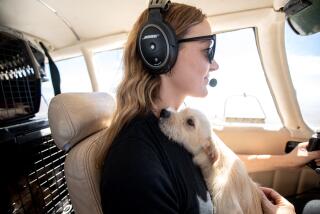Travel With Pets : Tips Before the Fur <i> Really</i> Flies
- Share via
In the recent saga of Tabitha the cat, who disappeared in the cargo hold of a jumbo jet for 12 days after a transcontinental flight, pet owners could well understand the anguish of Tabitha’s mistress. Lost luggage is a recognized hazard of air travel, but a missing pet can be a tragedy. Fortunately, Tabitha turned up safe.
The incident could give dog and cat owners reason to doubt the ability of the nation’s airlines to transport their pets safely. But tens of thousands of animals--show dogs and cats, zoo-bound creatures and pets--fly annually as cargo without harm, according to the American Society for the Prevention of Cruelty to Animals. American Airlines alone reports it carries 100,000 animals a year. Among all U.S. carriers, injury or death involving animals flying as cargo is very low. Nonetheless, there are risks.
“In the past 10 years, there’s been a drastic improvement in the way animals are being shipped,” said Kathi Travers, the society’s director of exotic animals and animal transportation. Currently, she is providing animal-care training for cargo crews of two major airlines. “My dogs fly all the time,” adds Priscilla Benkin, a spokeswoman for the American Dog Owners Assn., many of whose members, like Benkin, raise show dogs. Her organization also has pushed for improvement in animal transportation procedures.
But both organizations, as well as the Humane Society of the United States, urge pet owners to ship their animals by air only when necessary. “If you don’t absolutely have to do it, don’t,” said Humane Society spokeswoman Rachel Pancik. Shipping a pet is reasonable when you are moving permanently to another location or will be away for several weeks or months, the three groups agree. But a pet is better off at home with a pet-sitter or in a good kennel when you are taking a short vacation.
“Flying is the most stressful thing for animals,” Travers said.
But the effects of stress aren’t the only reason to think seriously before sending your pet into the belly of a jet. Lots of things can--and sometimes do--go wrong if you have not properly prepared your pet or if an airline makes a mistake. TWA recently was fined $60,000 after 51 puppies in a shipment of 100 destined for pet shops died a year ago in a closed cargo hold. The plane was delayed on the runway for 90 minutes in 100-degree summer heat, according to Stephen Smith of the Animal and Plant Health Inspection Service of the Department of Agriculture, the agency regulating animal shipments.
Smith and the animal welfare groups note that the cargo holds of many types of jet aircraft are poorly ventilated while the planes are on the ground. Normally, this is not a cause for undue concern, but when flight delays occur during hot weather, the animals inside may suffocate. Rachel Lamb, another spokeswoman for the Humane Society, advises pet owners to let the pilot know when they have a pet traveling in the cargo hold. Sometimes the pilots are not aware they are carrying animals, she said, a lapse in communication her organization is trying to remedy by pushing for legislation to require such pilot notification.
Unlike older planes, such as 727s and 737s, “newer model aircraft . . . have a system that forces air through the compartments, which helps keep them cool in the summer months while the aircraft are on the ground,” says the Air Transport Assn. of America, an organization of major U.S. airlines, in a brochure “Air Travel for Your Dog or Cat.”
At least two things went wrong when Tabitha got loose in the cargo hold of a Boeing 747 operated by Tower Air, a small New York-based carrier. Benkin contends the carrier in which the cat traveled--a container Benkin is familiar with and recognized from TV news coverage--was outmoded and inadequate. Doors often pop open on poor-quality containers, she said, and the animals escape. At the same time, Tower Air should never have accepted Tabitha for transport, since the carrier is not registered with the Animal and Plant Health Inspection Service as required by the federal Animal Welfare Act, Smith said.
At present, the federal government does not collect statistics on animal deaths, injuries or disappearances while being transported by air, but Smith said his agency is looking into the possibility of doing so.
Another reason to leave your pet at home is that shipping animals is a complex procedure that can require weeks of advance planning. Among the difficulties:
Shipping a pet is not a spur-of-the-moment decision. Animal welfare groups and pet experts strongly advise giving a pet that is flying for the first time a chance to become acquainted with the carrier in which it will be transported. At some point, the pet should be placed inside the container and taken on a car ride so it becomes accustomed to motion. Some animals are susceptible to motion sickness and should not fly.
You must reserve space on the plane for your pet, whether it is traveling in a carrier with you in the cabin or being shipped as checked baggage or as cargo. Airlines accept only a limited number of animals per flight, depending on the size of the plane.
Because of weather problems, your pet may not be permitted to fly on the day you have chosen to travel, and you may have to rearrange your schedule at the last minute for the safety of your pet. To abide by safety rules, airlines generally do not accept pets for transport if the temperature at the departure, connecting or arrival airport is higher than 85 degrees. You might have to switch to a later flight when the air has cooled or fly another day; either way, this means changing your ticket and plans. “We’ll try to work with you,” said Gus Whitcomb of American Airlines. But airline personnel are instructed to enforce the rule.
Some pets--especially dogs--should not fly because of their age, breed, disposition or health. These include pets under the age of eight weeks, which by law can’t be shipped as baggage or cargo; excitable dogs, which may tear off claws or break teeth trying to get out of the carrier; and sick, pregnant or elderly dogs. Dog experts such as Benkin also recommend against shipping pug-nose breeds because they have trouble breathing under normal circumstances and may not get enough air in flight. Airlines require that owners obtain a health certificate for their pet within 10 days of a flight. Ask the veterinarian if your pet is healthy enough to fly. Large dogs must be shipped in containers that may not fit into the cargo holds of some planes; you may have to plan an itinerary that takes you to destinations served by larger aircraft.
In addition to federal laws, each airline sets its own policies and rates for carrying pets. For example, not all airlines accept pets as carry-on baggage in passenger cabins. American doesn’t allow them to travel in cabins on foreign flights except to Canada and the Caribbean. Well ahead of a flight, you should check with your airline for its specific requirements. Foreign airlines serving the United States do not currently have to abide by federal animal-transport regulations.
But Smith believes his agency has the power to apply the rules to international airlines, and it is strongly considering doing so.
Many countries enforce quarantines on arriving animals. Make sure you are familiar with the local laws at your destination.
On American Airlines--which the American Dog Owners Assn. ranks as one of the best carriers for animal travel--a pet can fly four different ways:
As carry-on baggage. Exotic pets generally are banned, but small dogs and cats that fit into an under-the-seat carrier are accepted, although they are not protected by the Animal Welfare Act. Depending on plane size, no more than two pets can be carried on the same flight in first class and five in coach class, according to Whitcomb, so advance reservations should be made. Fees vary from airline to airline; American’s is $50 each way. Travers recommends carrying the pet in a soft-sided Sherpa bag, invented by a flight attendant and named for her dog. Sherpa bags sell in pet supply stores for about $40 to $70, depending on size.
As checked baggage. Luggage and pets fly in the same cargo hold. Fees vary; on American they are $50 each way. Typically, you hand over the pet in an approved carrier when you check in for your flight. American sells carriers at many of its airport ticketing and cargo offices for $45 to $90, depending on size. But don’t wait until flight time to buy one; your pet won’t have time to get used to it. Generally, most airlines won’t transfer a pet to a connecting flight on another airline; you will have to retrieve your pet at the baggage claim area and re-check it. Ask ahead about transfer policies.
As a “priority parcel” shipment. Use this if you are shipping the pet to someone else and are not accompanying it on the flight. With “priority,” you can pick the flight the pet will travel on. The cost depends on the destination and the weight and dimensions of the carrier. Typically, you deposit the pet at the air freight office no more than two to four hours in advance of the flight. Reservations are required but can be made no more than 24 hours in advance.
As regular cargo. The same as a priority shipment, except you pick the day the pet flies, not the specific flight.
By law, airlines are required to provide pets carried as luggage or cargo with water every 12 hours and with food every 24 hours. Puppies and kittens under 16 weeks get fed every 12 hours. Generally, pets should not be fed six hours prior to a flight--to avoid an upset stomach--but a moderate amount of water is advised up to an hour before departure.
Travers suggests freezing a water bowl three-quarters full and placing it in the container when you leave for the airport. The water won’t spill while the container is being loaded but will have melted for the flight.
Several animal welfare groups, federal agencies and pet experts have compiled suggestions for your pet’s flight:
Don’t use an inadequate container. By Department of Agriculture standards, a proper carrier “must allow room for the animal to stand, sit, breathe and rest comfortably.”
Make sure your name, address, phone number and destination are on the top of the container.
GUIDEBOOK: Animals’ Best Friends
Several organizations offer free publications with tips on transporting a pet by air. Send a business-size, self-addressed and stamped envelope to:
Animal and Plant Health Inspection Service, Animal Care Staff, 6505 Belcrest Road, Hyattsville, Md. 20782; telephone (301) 436-7833. Ask for “Traveling by Air With Your Pet.” Complaints of animal mistreatment involving airline personnel should be sent to this office.
Consumer Affairs Office, I-25, U.S. Department of Transportation, 400 7th St. SW, Washington, D.C. 20590; tel. (202) 366-2220. Ask for “Plane Talk: Transporting Live Animals.” Complaints about animals lost in air transport or questions about reimbursement for losses should be directed to this office.
American Society for the Prevention of Cruelty to Animals, Education Department, 424 E. 92nd St., New York, N.Y. 10128; tel. (212) 876-7700. Ask for “Travel Tip Sheets.”
Humane Society of the United States, 2100 L St. NW, Attn: Air, Washington, D.C. 20037; tel. (202) 452-1100.
Air Transport Assn. of America, 1301 Pennsylvania Ave. NW, Suite 1100, Washington, D.C. 20004; tel. (202) 626-4000. Ask for “Air Travel for Your Dog or Cat.”
More to Read
Sign up for The Wild
We’ll help you find the best places to hike, bike and run, as well as the perfect silent spots for meditation and yoga.
You may occasionally receive promotional content from the Los Angeles Times.






